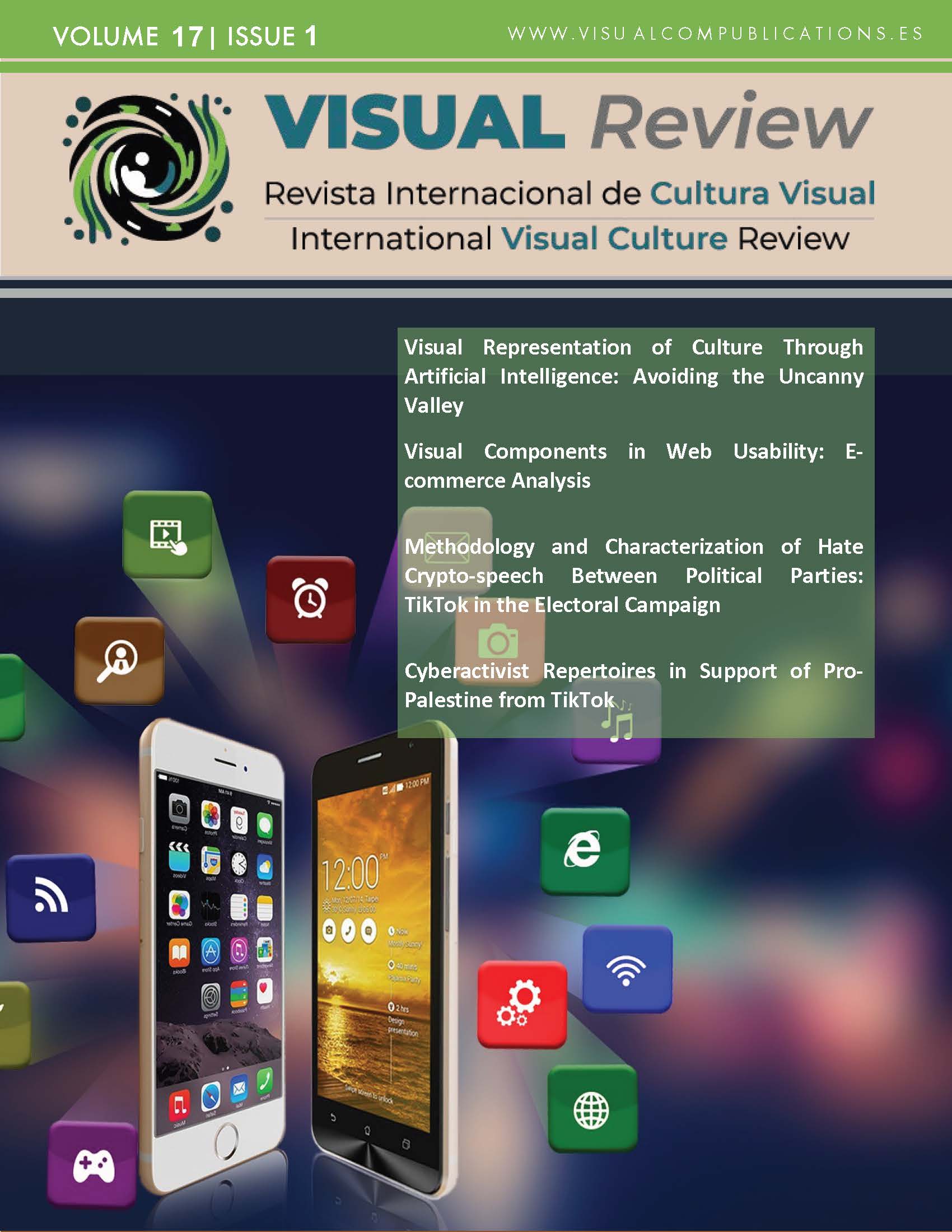Cyberactivist Repertoires in Support of Pro-Palestine from TikTok
DOI:
https://doi.org/10.62161/revvisual.v17.5340Keywords:
Cyberactivism, Slacktivism, Clicktivism, Palestine, Israel, TikTokAbstract
The historical trajectories of the Palestinian-Israeli conflict have recently found new forms of expression mobilized by the social network TikTok. Using Van Laer and Van Aelst's method of analysis of cyberactivism repertoires, 200 TikToks with hashtags associated with the pro-Palestinian cause were examined. The results show that there is viralization of communicative pieces in which emotional narratives prevail, but also contents that make pedagogy of the conflict from reasoned arguments. The discussion highlights how TikTok has redefined social mobilization strategies and the architecture of the international system through digital collective action.
Downloads
Global Statistics ℹ️
|
838
Views
|
239
Downloads
|
|
1077
Total
|
|
References
Abbas, L., Fahmy, S. S., Ayad, S., Ibrahim, M., & Ali, A. H. (2022). TikTok Intifada: Analyzing Social Media Activism Among Youth. Online Media and Global Communication, 1(2), 287–314. https://doi.org/10.1515/omgc-2022-0014 DOI: https://doi.org/10.1515/omgc-2022-0014
Abuzayyad, Z. (2015). Freedom of Expression and Social Media in Palestine. Palestine - Israel Journal of Politics, Economics, and Culture, 21(2), 40–42. https://www.proquest.com/openview/b338b041e19486bb938345572d46f52e/1?pq-origsite=gscholar&cbl=26627
Agnew, S. (2014). Rational choice theory. En A Companion to Criminal Justice, Mental Health & Risk. https://doi.org/10.4324/9781315573946-13 DOI: https://doi.org/10.4324/9781315573946-13
Alperstein, N. (2021). Performing Media Activism in the Digital Age. Springer International Publishing. https://doi.org/10.1007/978-3-030-73804-4 DOI: https://doi.org/10.1007/978-3-030-73804-4
Banton, M. (1995). Rational Choice Theories. American Behavioral Scientist. https://doi.org/10.1177/0002764295038003008 DOI: https://doi.org/10.1177/0002764295038003008
BBC. (2023, octubre 17). ¿Qué pasará en Gaza tras los combates? y otras 6 preguntas sobre el conflicto entre Hamás e Israel respondidas por los expertos de la BBC. BBC. https://www.bbc.com/mundo/articles/crg131gx98zo
Boulianne, S. (2019). Revolution in the making? Social media effects across the globe. Information, Communication and Society, 22(1), 39–54. https://doi.org/10.1080/1369118X.2017.1353641 DOI: https://doi.org/10.1080/1369118X.2017.1353641
Bunnage, L. (2014), Social Movement Engagement over the Long Haul: Understanding Activist Retention. Sociology Compass, 8, 433-445. DOI: https://doi.org/10.1111/soc4.12141
Brodersen, R. (2018). Emotional Motives in International Relations: Rage, Rancour and Revenge. Routledge. DOI: https://doi.org/10.4324/9781351175302
Cabral, S., & Faguy, A. (2024, April 26). What do pro-Palestinian student protesters at US universities want? BBC. https://www.bbc.com/news/world-us-canada-68908885
Cárdenas Mata , S., & Veytia Bucheli, M. G. . (2023). La red social TikTok como proyección emocional de los adolescentes. Revista Iberoamericana De Investigación En Educación, (7). https://doi.org/10.58663/riied.vi7.128 DOI: https://doi.org/10.58663/riied.vi7.128
Carty, V., & Reynoso Barron, F. G. (2019). Social Movements and New Technology: The Dynamics of Cyber Activism in the Digital Age. In B. Berberoglu (Ed.), The Palgrave Handbook of Social Movements, Revolution, and Social Transformation (pp. 373–397). Springer International Publishing. https://doi.org/10.1007/978-3-319-92354-3_16 DOI: https://doi.org/10.1007/978-3-319-92354-3_16
Castillo-Esparcia, A., Caro-Castaño, L., & Almansa-Martí¬nez, A. (2023). Evolution of digital activism on social media: opportunities and challenges. Profesional De La información, 32(3). https://doi.org/10.3145/epi.2023.may.03 DOI: https://doi.org/10.3145/epi.2023.may.03
Cervi, L., & Divon, T. (2023). Playful Activism: Memetic Performances of Palestinian Resistance in TikTok #Challenges. Social Media + Society, 9(1), 20563051231157607. https://doi.org/10.1177/20563051231157607 DOI: https://doi.org/10.1177/20563051231157607
Chayka, K. (2022, March 3). Ukraine Becomes the World’s “First TikTok War.” The New Yorker. https://www.newyorker.com/culture/infinite-scroll/watching-the-worlds-first-tiktok-war
Cintra Torres, E., & Mateus, S. (Eds.). (2015). From multitude to crowds: Collective action and the media [EPUB]. Peter Lang Gmbh, Internationaler Verlag Der Wissenschaften. https://doi.org/10.3726/978-3-653-05926-7 DOI: https://doi.org/10.3726/978-3-653-05926-7
Crawford, N. (2000). The Passion of World Politics: Propositions on Emotion and Emotional Relationships. International Security, 24(4), 116-156. DOI: https://doi.org/10.1162/016228800560327
Datareportal. (2024). Digital 2024: Global Overview Report. Datareportal. https://datareportal.com/reports/digital-2024-global-overview-report
Dimitrova, D. V., & Matthes, J. (2018). Social Media in Political Campaigning Around the World: Theoretical and Methodological Challenges. Journalism & Mass Communication Quarterly, 95(2), 333–342. https://doi.org/10.1177/1077699018770437 DOI: https://doi.org/10.1177/1077699018770437
Earl, J., & Kimport, K. (2013). Digitally Enabled Social Change: Activism in the Internet Age. MIT Press. https://play.google.com/store/books/details?id=_uf5mwEACAAJ
Euronews. (2023, octubre 7). «Estamos en guerra» declara Netanyahu tras el ataque sin precedente de Hamás contra Israel. https://es.euronews.com/2023/10/07/israel-declara-el-estado-de-guerra-tras-un-fuerte-ataque-multiple-desde-gaza
García, J. A. (2023). La guerra TikTokeada: el usuario es el mensaje en la Sociedad Red. En La mirada mediática. Una revisión de la actualidad desde las Teorías de la Comunicación (pp. 13-30.). Fragua.
García-Jiménez, A., Suárez-Álvarez, R., & Catalina-García, B. (2024). Guerra Rusia-Ucrania. Difuminando los límites de las noticias: actualidad a través de perfiles en TikTok. Revista Mediterránea De Comunicación, 15(2), e25547. https://doi.org/10.14198/MEDCOM.25547 DOI: https://doi.org/10.14198/MEDCOM.25547
García, R. G., & Treré, E. (2014). The #YoSoy132 movement and the struggle for media democratization in Mexico. Convergence, 20(4), 496–510. https://doi.org/10.1177/1354856514541744 DOI: https://doi.org/10.1177/1354856514541744
George, J. J., & Leidner, D. E. (2019). From clicktivism to hacktivism: Understanding digital activism. Information and Organization, 29(3), 100249. https://doi.org/10.1016/j.infoandorg.2019.04.001 DOI: https://doi.org/10.1016/j.infoandorg.2019.04.001
Gilardi, F., Gessler, T., Kubli, M., & Müller, S. (2022). Social Media and Political Agenda Setting. Political Communication, 39(1), 39–60. https://doi.org/10.1080/10584609.2021.1910390 DOI: https://doi.org/10.1080/10584609.2021.1910390
Haddad, K., & Chalabi, H. (2023, November 14). The Instafada: social media as resistance. Shado Magazine. https://shado-mag.com/act/the-instafada-social-media-as-resistance/
Hamed, A. (2024, May 12). TikTokers call to block celebs after “tone deaf” Met Gala. The New Arab. https://www.newarab.com/news/tiktokers-call-block-celebs-after-tone-deaf-met-gala
Hill, S. (2013). Digital Revolutions: Activism in the Internet Age. New Internationalist. https://play.google.com/store/books/details?id=fMj0AgAAQBAJ
Hitchcock, J. (2016). Social Media Rhetoric of the Transnational Palestinian-led Boycott, Divestment, and Sanctions Movement. Social Media + Society, 2(1), 2056305116634367. https://doi.org/10.1177/2056305116634367 DOI: https://doi.org/10.1177/2056305116634367
Janfaza, R. (2020, June 4). TikTok serves as hub for #blacklivesmatter activism. CNN. https://www.cnn.com/2020/06/04/politics/tik-tok-black-lives-matter/index.html
Karatzogianni, A. (2015). Introduction: Four Phases of Digital Activism and Cyberconflict. In A. Karatzogianni (Ed.), Firebrand Waves of Digital Activism 1994–2014: The Rise and Spread of Hacktivism and Cyberconflict (pp. 1–4). Palgrave Macmillan UK. https://doi.org/10.1057/9781137317933_1 DOI: https://doi.org/10.1057/9781137317933_1
Karpf, D. (2020). After clicktivism. In A Research Agenda for Digital Politics (pp. 123–132). Edward Elgar Publishing. https://doi.org/10.4337/9781789903096.00022 DOI: https://doi.org/10.4337/9781789903096.00022
Kaul, V. (2012). The Digital Communications Revolution. Online Journal of Communication and Media Technologies, 2(3). https://doi.org/10.29333/ojcmt/2392 DOI: https://doi.org/10.29333/ojcmt/2392
Kaur, H. (2024, January 19). Palestinians are documenting the war for millions on social media. Their followers have come to see them as family. CNN. https://www.cnn.com/2024/01/19/world/palestinians-x-tiktok-instagram-gaza-cec/index.html
Khan, G. F. (2017). Social Media for Government: A Practical Guide to Understanding, Implementing, and Managing Social Media Tools in the Public Sphere. Springer Nature Singapore. https://doi.org/10.1007/978-981-10-2942-4 DOI: https://doi.org/10.1007/978-981-10-2942-4_2
Leong, C., Pan, S. L., Bahri, S., & Fauzi, A. (2019). Social media empowerment in social movements: power activation and power accrual in digital activism. European Journal of Information Systems, 28(2), 173–204. https://doi.org/10.1080/0960085X.2018.1512944 DOI: https://doi.org/10.1080/0960085X.2018.1512944
Levin, I., & Mamlok, D. (2021). Culture and Society in the Digital Age. Information. An International Interdisciplinary Journal, 12(2), 68. https://doi.org/10.3390/info12020068 DOI: https://doi.org/10.3390/info12020068
Lilleker, D. G., & Koc-Michalska, K. (2017). What Drives Political Participation? Motivations and Mobilization in a Digital Age. Political Communication, 34(1), 21–43. https://doi.org/10.1080/10584609.2016.1225235 DOI: https://doi.org/10.1080/10584609.2016.1225235
Maheshwari, S. (2024, March 28). How the Israel-Hamas War Has Roiled TikTok Internally. The New York Times. https://www.nytimes.com/2024/03/28/business/tiktok-israel-hamas-war-gaza.html
Martín, S. (2023). Cómo encontrar el hashtag perfecto en TikTok. Metricool. https://metricool.com/es/hashtags-para-tiktok/
Massal, J. (2019). Emociones y movilización de alto riesgo en un contexto de posacuerdo de paz: una reflexión en torno al caso colombiano. Desafíos, 31(2), 133-167. DOI: https://doi.org/10.12804/revistas.urosario.edu.co/desafios/a.7306
Millaleo, S., & Velasco, P. (2013). Activismo digital en Chile. Repertorios de contención e iniciativas ciudadanas. Fundación Democracia y Desarrollo.
Moïsi, D. (2009). The Geopolitics of Emotions. Anchor Books.
Monshipouri, M., & Prompichai, T. (2017). Digital activism in perspective: Palestinian resistance via social media. Int’l Stud. J. https://heinonline.org/hol-cgi-bin/get_pdf.cgi?handle=hein.journals/isudijo14§ion=38
Morozov, E. (2009, May 19). The brave new world of slacktivism. Foreign Policy. https://foreignpolicy.com/2009/05/19/the-brave-new-world-of-slacktivism/
Mosca, L. (2010). From the Streets to the Net? The Political Use of the Internet by Social Movements. International Journal of E-Politics, 1(1), 1–21. DOI: https://doi.org/10.4018/jep.2010102201
Murphy, D. (2015). Hasbara in action. Irish Pages, 9(2), 181–212. http://www.jstor.org/stable/44508361
Niño, C. (2024, abril 21). Ataques entre Israel e Irán: causas y consecuencias. Razón Pública. https://razonpublica.com/ataques-israel-e-iran-causas-consecuencias/
Niño, C., & Sánchez, J. (2020). La securitización del cine en el siglo XX: interpretaciones sobre la cultura y el poder. Via Inveniendi Et Iudicandi, 15(1), 189-217. https://doi.org/10.15332/19090528/5746 DOI: https://doi.org/10.15332/19090528/5746
Ozkula, S. M. (2021). What is digital activism anyway? Journal of Digital Social Research, 3(3), 60–84. https://doi.org/10.33621/jdsr.v3i3.44 DOI: https://doi.org/10.33621/jdsr.v3i3.44
Passy, F., y Giugni, M. (2001). Social Networks and Individual Perceptions: Explaining Differential Participation in Social Movements. Sociological Forum, 16(1), 123-153 DOI: https://doi.org/10.1023/A:1007613403970
Paton, E. (2024, May 17). Why TikTok Users Are Blocking Celebrities. The New York Times. https://www.nytimes.com/2024/05/17/fashion/tiktok-block-lists-celebrities.html
Pequeño, S. (2024, April 30). College students are telling you exactly how they feel about the Israel-Hamas war. Listen. USA Today. https://acortar.link/t8HWuo
Postill, J. (2014). Democracy in an age of viral reality: A media epidemiography of Spain’s indignados movement. Ethnography, 15(1), 51–69. http://www.jstor.org/stable/24467135 DOI: https://doi.org/10.1177/1466138113502513
Prentoulis, M., & Kyriakidou, M. (2019). Media and Collective Action in Greece: From Indignation to Solidarity. International Journal of Communication Systems, 13(0), 19. https://ijoc.org/index.php/ijoc/article/view/7870/2520
Qarjouli, A. (2023, November 15). Israel admits “hasbara” efforts are struggling as global coverage centres brutality in Gaza. Doha News | Qatar. https://dohanews.co/israel-admits-hasbara-efforts-are-struggling-as-global-coverage-centres-brutality-in-gaza/
Rodríguez-Romero, M.A. (2022). Repertorios de activismo digital en la defensa de territorios con proyectos de infraestructura y extractivismo: los casos del Golfo de Tribugá y el Páramo de Santurbán. Tesis Maestría. Universidad Distrital Francisco José de Caldas.
Rodríguez-Romero, M. A. & Cuello, C. (2022). Activismo digital y reconfiguración de los territorios con impacto medioambiental. En Gestos, tecnologías y sociedades: tendencias y emergencias en tiempos de pospandemia (pp.73-101). Editorial Politécnico Internacional.
Rodriguez, J. (2022). La guerra en TikTok: la red social de la invasión rusa a Ucrania. Sociedad digital, comunicación y conocimiento: retos para la ciudadanía en un mundo global, 150-168.
Rotman, D., Vieweg, S., Yardi, S., Chi, E., Preece, J., Shneiderman, B., Pirolli, P., & Glaisyer, T. (2011). From slacktivism to activism: participatory culture in the age of social media. CHI ’11 Extended Abstracts on Human Factors in Computing Systems, 819–822. https://doi.org/10.1145/1979742.1979543 DOI: https://doi.org/10.1145/1979742.1979543
Sádaba, I. (2012). Acción colectiva y movimientos sociales en las redes digitales. Aspectos históricos y metodológicos. ARBOR Ciencia, Pensamiento y Cultura, 188 (756), 781-794. DOI: https://doi.org/10.3989/arbor.2012.756n4011
Sasley, B. (2013, junio 12). Emotions in International Relations. E-International Relations.
Seo, H. (2014). Visual Propaganda in the Age of Social Media: An Empirical Analysis of Twitter Images During the 2012 Israeli–Hamas Conflict. Visual Communication Quarterly, 21(3), 150–161. https://doi.org/10.1080/15551393.2014.955501 DOI: https://doi.org/10.1080/15551393.2014.955501
Smidi, A., & Shahin, S. (2017). A Survey of Research on the Arab Spring. India Quarterly, 73(2), 196–209. https://www.jstor.org/stable/48505308 DOI: https://doi.org/10.1177/0974928417700798
Sontag, S. (2010). Ante el dolor de los demás (6.a ed.). Penguin Random House Group.
Stieglitz, S., & Dang-Xuan, L. (2013). Social media and political communication: a social media analytics framework. Social Network Analysis and Mining, 3(4), 1277–1291. https://doi.org/10.1007/s13278-012-0079-3 DOI: https://doi.org/10.1007/s13278-012-0079-3
Tannenwald, N. (1999). The nuclear taboo: The United States and the normative basis of nuclear non-use. International organization, 53(3), 433-468. DOI: https://doi.org/10.1162/002081899550959
The Guardian. (2023, octubre 10). Israel-Hamas war live: Netanyahu says Israel’s siege ‘just getting started’; Hamas threatens hostage executions. The Guardian.
Tufekci, Z. (2017). Twitter and Tear Gas: The Power and Fragility of Networked Protest. Yale University Press. https://play.google.com/store/books/details?id=ZITAswEACAAJ
van Laer, J., y van Aelst, P. (2010). Internet and Social Movement Action Repertoires. Information, Communication & Society, 13(8), 1146–1171. DOI: https://doi.org/10.1080/13691181003628307
Vidmar, J. (2015). The Concept of the State and its Right of Existence. Cambridge Journal of International and Comparative Law, 4(3). https://doi.org/10.7574/cjicl.04.03 DOI: https://doi.org/10.7574/cjicl.04.03.547
Waid, M. (2013). La auténtica verdad sobre Superman (y sobre todos nosotros). En T. Morris & M. Morris (Eds.), Los superhéroes y la filosofía (primera, p. 427). Blackie Books.
Wilches, J., Guerrero, H., & Niño, C. (2024). Emociones políticas y narrativas prototípicas: TikTok en las campañas políticas, estudio de caso. Revista Latina de Comunicación Social, 82, 1–28. https://doi.org/10.4185/rlcs-2024-2234 DOI: https://doi.org/10.4185/rlcs-2024-2234
Williams, M. C. (2003). Words, images, enemies: Securitization and international politics. International Studies Quarterly. https://doi.org/10.1046/j.0020-8833.2003.00277.x DOI: https://doi.org/10.1046/j.0020-8833.2003.00277.x
Wolfsfeld, G., Segev, E., & Sheafer, T. (2013). Social Media and the Arab Spring: Politics Comes First. The International Journal of Press/Politics, 18(2), 115–137. https://doi.org/10.1177/1940161212471716 DOI: https://doi.org/10.1177/1940161212471716
Wulf, V., Aal, K., Abu Kteish, I., Atam, M., Schubert, K., Rohde, M., Yerousis, G. P., & Randall, D. (2013). Fighting against the wall: social media use by political activists in a Palestinian village. Proceedings of the SIGCHI Conference on Human Factors in Computing Systems, 1979–1988. https://doi.org/10.1145/2470654.2466262 DOI: https://doi.org/10.1145/2470654.2466262
Yarchi, M., & Boxman-Shabtai, L. (2023). The Image War Moves to TikTok Evidence from the May 2021 Round of the Israeli-Palestinian Conflict. Digital Journalism, 1–21. https://doi.org/10.1080/21670811.2023.2291650 DOI: https://doi.org/10.1080/21670811.2023.2291650
Downloads
Published
How to Cite
Issue
Section
License
Copyright (c) 2025 VISUAL REVIEW. International Visual Culture Review / Revista Internacional de Cultura Visual

This work is licensed under a Creative Commons Attribution-NoDerivatives 4.0 International License.
Those authors who publish in this journal accept the following terms:
-
Authors retain copyright.
-
Authors transfer to the journal the right of first publication. The journal also owns the publishing rights.
-
All published contents are governed by an Attribution-NoDerivatives 4.0 International License.
Access the informative version and legal text of the license. By virtue of this, third parties are allowed to use what is published as long as they mention the authorship of the work and the first publication in this journal. If you transform the material, you may not distribute the modified work. -
Authors may make other independent and additional contractual arrangements for non-exclusive distribution of the version of the article published in this journal (e.g., inclusion in an institutional repository or publication in a book) as long as they clearly indicate that the work was first published in this journal.
- Authors are allowed and recommended to publish their work on the Internet (for example on institutional and personal websites), following the publication of, and referencing the journal, as this could lead to constructive exchanges and a more extensive and quick circulation of published works (see The Effect of Open Access).













